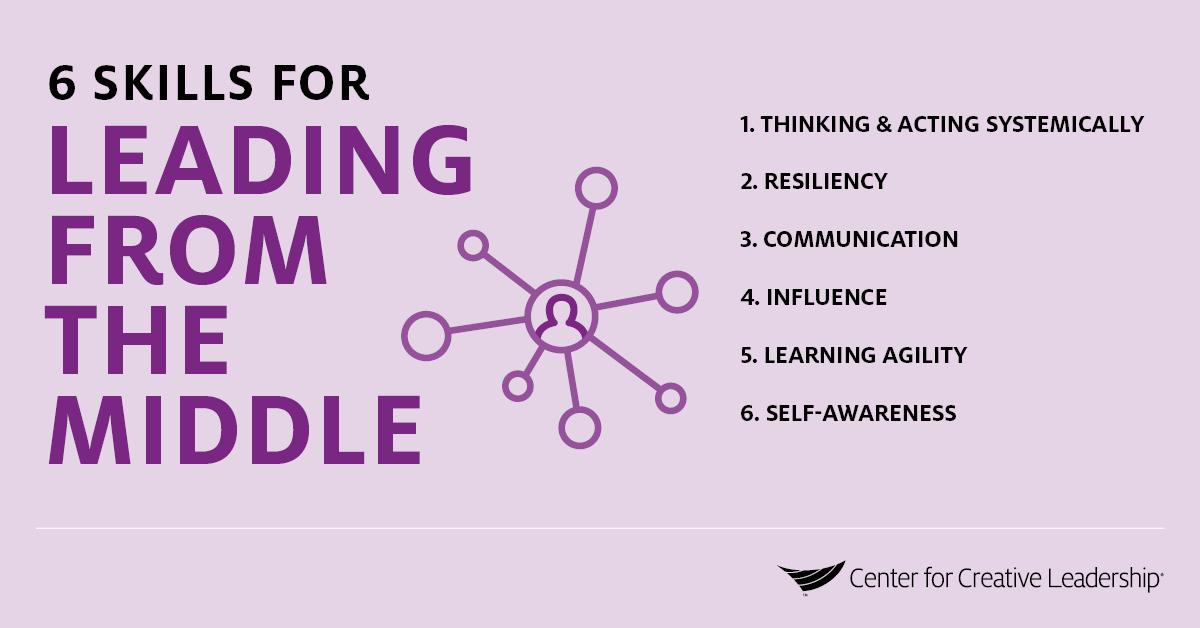Overcoming the Challenges of Leading from the Middle
Working and leading from the middle is tough.
Your boss has priorities. Your direct reports have questions. Peers and colleagues ask you for help and toss extra projects your way. The result: You regularly get pulled in different directions.
Working hard and helping others has gotten you this far in your career, but now, new skills are required in order to keep advancing.
“Often, people who are leading in the middle find themselves taking on more work and stuck between the competing priorities that exist within the organizational structure,” says Lisa Sinclair, one of our senior faculty who leads several of our middle manager training programs.
According to Sinclair, middle managers often take these competing demands personally. But they shouldn’t.
“The truth is, that’s often the system — you just happen to be in the middle of it,” she says.
Those leading in the middle may include general managers, plant managers, regional managers, divisional managers, directors, and sometimes even vice presidents.
But leading from the middle isn’t about a position; it’s about meeting the demands from above while providing resources to and meeting the needs of those below. Below you’ll learn what our research has found that middle managers need to succeed.
The 6 Leadership Skills Middle Managers Need
Based on decades of our research and work with over 100,000 middle managers around the world who’ve taken our flagship Leadership Development Program (LDP)® — the longest-running program for middle managers in the world — we know that the 6 leadership skills middle managers most need are:
- Thinking and acting systemically
- Resiliency
- Communication
- Influence
- Learning agility
- Self-awareness
Key Skills to Lead from the Middle
1. Thinking and Acting Systemically
This requires seeing the big picture, broadening your perspective, seeing patterns in relationships and processes, and dealing with the uncertainties and trade-offs that are part of the complexities of organizations. Give up the need to constantly please. While trying to please everyone, you may find that you’re doing a lot each day, but doubting your ability, impact, and success.
This requires self-control and clarity. You need to have understanding and empathy for others — but you can’t let everybody’s “stuff” allow you to lose focus.
2. Resiliency
Leadership resiliency is about handling stress, uncertainty, and setbacks well — learning to maintain equilibrium under pressure. In our leadership programs, we spend a lot of time helping participants find tools for building resiliency for themselves and for others in their organization.
3. Communication
Communication is a core leadership function, requiring the ability to think with clarity and to express ideas and information to a multitude of audiences. Effective communication is also about listening, asking questions, and aligning words and actions.
At work, we need to be skilled communicators in countless relationships — at the organizational level, and sometimes on a global scale. Today’s leaders must also learn to handle the rapid flows of information within the organization and among customers, partners, and other stakeholders and influencers. Learn why communication is so important for leaders.
4. Influence
This means gaining cooperation to get things done. In today’s flattened or matrixed organizations, position or expertise alone doesn’t give you influence.
You may be met with resistance or compliance, but what you — and your business — need is commitment. It’s important to develop a range of influencing styles to help you get different people with different perspectives on board. You can master the 4 keys to influence others.
5. Learning Agility
Seek opportunities to learn and learn quickly. To be good at anything requires some knowledge, skills, and technical know-how. But what separates the remarkable middle managers from the merely good ones is the ability to adjust, adapt, respond, and be resourceful in the face of change. So always keep learning; it’s how to enjoy a long career.
6. Self-Awareness
When you truly understand your own style, motivation, strengths, shortcomings, quirks, and preferences, you’re better equipped to make day-to-day decisions, leverage your strengths and minimize your weaknesses, and navigate the big picture for yourself and for your organization. Here are 4 sure-fire ways to boost your self-awareness.
If you’re leading from the middle, you’re in the right place to collaborate with other managers to generate new ideas and solve problems. Middle managers can gain great experience, be involved in interesting work, have significant organizational impact, and enjoy long careers.
In short, those who are able to harness and develop the 6 leadership skills listed above can truly “lead from the middle” effectively. They’re also more likely to advance, keep their careers on track and avoid derailment, and better able to manage not only work obligations, but also family, community, and personal demands.
Developing Middle Managers Through Leadership Training
Managers who spend significant time leading from the middle must give up the need to constantly please. As you’re pulled from all directions, it’s important to stay focused on thinking and acting systemically by seeing the big picture and understanding how the various parts of the organization function together.
As middle managers learn how to get things done with the help of others, they become more effective leaders. “The higher up you go, the more you have to learn to work through other people and influence the system,” Sinclair says.
Our middle manager training programs are designed to help middle managers develop these essential leadership skills and make this leap. Program participants learn to be more effective leaders and:
- Bridge the gap between senior management and the front line;
- Lead across organizational or geographic boundaries, including leading virtual and hybrid teams;
- Collaborate with others, including those with different communication styles, personalities, and backgrounds;
- Manage stress, build resilience, and leverage multiple life roles; and
- Solve complicated problems and take wise action in a complex, rapidly changing environment.
In our programs, we help you “take down walls across the organization to really learn what it’s like to sit in those different seats,” Sinclair notes, “so you can have a greater and deeper appreciation for how the organization really works.”
Ready to Take the Next Step?
If you’re responsible for developing middle managers or directors, or if you’re leading from the middle yourself, grow the skills needed for success with our flagship Leadership Development Program (LDP)®, available in both face-to-face and online formats, or explore all our options for middle manager training.









